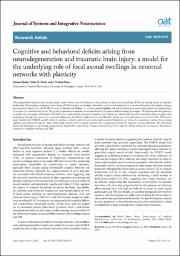
ATTENTION: The works hosted here are being migrated to a new repository that will consolidate resources, improve discoverability, and better show UTA's research impact on the global community. We will update authors as the migration progresses. Please see MavMatrix for more information.
Show simple item record
| dc.contributor.author | Rudy, Samuel | |
| dc.contributor.author | Maia, Pedro D. | |
| dc.contributor.author | Kutz, J. Nathan | |
| dc.date.accessioned | 2021-05-27T15:18:32Z | |
| dc.date.available | 2021-05-27T15:18:32Z | |
| dc.date.issued | 2016-03-28 | |
| dc.identifier.issn | 2059-9781 | |
| dc.identifier.uri | http://hdl.handle.net/10106/29740 | |
| dc.description.abstract | **Please note that the full text is embargoed** ABSTRACT: Neurodegenerative diseases and traumatic brain injury, whose hallmark features are the presence of focal axonal swellings (FAS), are leading causes of cognitive dysfunction. By leveraging biophysical observations of FAS statistics, we develop a theoretical model of functional neural network activity driven by adaptive changes from plasticity. Based upon the FORCE model of Sussillo and Abbott [1], our innovations highlight the role of plasticity in overcoming injuries and degeneration of neurons in a network architecture. We provide a quantitative measure, on a network level, of cognitive deficits arising from injury. We demonstrate that plasticity is capable of overcoming mild injuries while failing to compensate for more severe injuries. Such injuries are characterized by their underlying effect on spike trains propagating through the neurons in a network architecture. Specifically, spike trains can be filtered in firing rate, or blocked under more severe FAS. The level of injury dictates the FORCE model’s ability to produce a desired output functionality (and associated behavior) and allows for quantitative metrics for accessing cognitive and behavioral deficits. Thus a direct link between FAS in neural networks and compromised functional response can be established. The theoretical framework developed is a promising computational framework for providing a deeper understanding of the cognitive deficits arising in, for instance, Alzheimer’s, Parkinson’s, Multiple-Sclerosis, and TBI. [This is an open-access article distributed under the terms of the Creative Commons Attribution License, which permits unrestricted use, distribution, and reproduction in any medium, provided the original author and source are credited. DOI: 10.15761/JSIN.1000120] | en_US |
| dc.language.iso | en_US | en_US |
| dc.publisher | Open Access Text | en_US |
| dc.relation.ispartofseries | Journal of Systems and Integrative Neuroscience; Volume 2 | |
| dc.title | Cognitive and behavioral deficits arising from neurodegeneration and traumatic brain injury: a model for the underlying role of focal axonal swellings in neuronal networks with plasticity | en_US |
| dc.type | Article | en_US |
| dc.identifier.doi | 10.15761/JSIN.1000120 | |
Files in this item
- Name:
- PDF
- Size:
- 950.0Kb
- Format:
- PDF
This item appears in the following Collection(s)
Show simple item record


